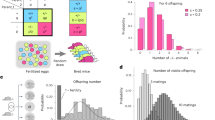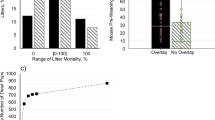Abstract
IT is nearly always desirable, when breeding animals like mice for laboratory use, to select for high productivity, that is, for the largest number of healthy offspring per dam in a given time. This is a function of litter size and ‘pre-natal interval’; the time between exposure to the chance of mating and the birth of the first litter, or the time between the births of successive litters. The pre-natal interval is only of interest for monogamous pairs which are never separated.
This is a preview of subscription content, access via your institution
Access options
Subscribe to this journal
Receive 51 print issues and online access
$199.00 per year
only $3.90 per issue
Buy this article
- Purchase on SpringerLink
- Instant access to full article PDF
Prices may be subject to local taxes which are calculated during checkout
Similar content being viewed by others
References
Carter, T. C., J. Anim. Tech., 1, 4 (1951).
Lane-Petter, W., J. Hyg. (Camb.), 53, 234 (1955).
Author information
Authors and Affiliations
Rights and permissions
About this article
Cite this article
LANE-PETTER, W., BROWN, A., COOK, M. et al. Measuring Productivity in Breeding of Small Animals. Nature 183, 339 (1959). https://doi.org/10.1038/183339a0
Issue date:
DOI: https://doi.org/10.1038/183339a0



